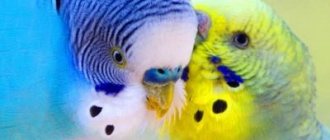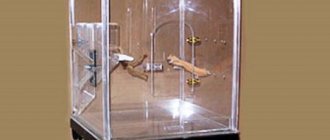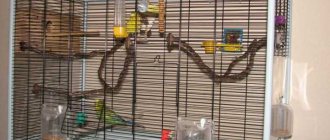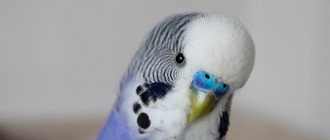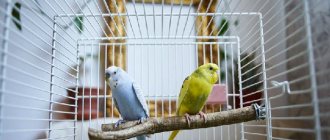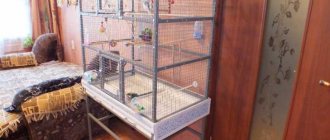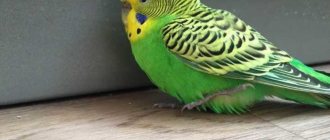With the help of a blanket you can create conditions for the bird to sleep at any time of the day. Since parrots see poorly in the dark and twilight, they quickly fall asleep. You can regulate the length of your pet's day and night.
Any dense fabric that does not allow light to pass through and does not have lint or protruding threads is suitable for covering the cage.
Should I close it?
Each person independently decides whether to cover the cage at night.
This is not a necessary process, since birds calmly fall asleep in the dark. The most important thing is that the room is dark enough.
But birds wake up quite early, so if the curtains are open in the room, the parrot will start running, eating and screaming very early.
If a person wants to sleep longer, then he can cover the cage with some kind of fabric, but it should not be too dense, and you still need to leave a place that allows oxygen to freely penetrate into the cage.
It is advisable to close the cage if you need to work in the light at night , but this will not disturb the pet’s routine.
Colds and treatments
During a cold, the parrot's mouth becomes inflamed, acquiring characteristic redness. The organs of the mouth increase in volume. The pet may regurgitate grains and swallow frequently. By clicking its beak, it tries to eliminate the discomfort of the mucous membranes of the throat and oral cavity.
When a bird has a cold, its body temperature drops quickly. Chills appear, expressed in the manifestations of convulsions and ruffled plumage. In this case, you need to use artificial heating to create a comfortable temperature for the chick. An ordinary incandescent lamp with a power of up to 60 W is used as a heater. The lamp should be positioned in such a way that the parrot does not get overheated or get burned.
Peculiarities of bird sleep in natural conditions
Budgerigars are native to Australia. In their natural habitat, birds search for food and raise chicks. They have to search for food and water on their own. They cross significant distances every day, which requires a lot of strength. To do this, they need a full night's sleep, and they also often sleep during the day.
In Australia, the temperature rises high by lunchtime, so the birds hide from the sun in the shade of trees. At this time they rest and gain strength. They choose a place that will be well protected from predators.
Parrots that live at home still have their instincts. Therefore, they can sleep not only at night, but also during the day, so this behavior should not frighten the owners.
It is also useful to read: How can you determine the gender of a budgie?
When does this happen
This sound appears suddenly and everyone remembers it because of its unfamiliarity, since many perceive it as a creaking, others - a crackling, clicking and the like.
The clicking of the beak is most often heard after the bird has eaten, since on the inside of the beak the parrot has teeth with which it chews hard fruits, cleans the husks from grains, and it can get stuck in the teeth. Therefore, after eating or in the evening before going to bed, sitting on a perch, the feathered pet tries to get rid of stuck food residues, thereby making such extraordinary sounds.
You can try to explain the sound being made - it’s as if the bird had filled its mouth with seeds in reserve and now began to click them. But the parrot never does this; he eats near the feeder, removing grains from the shell.
Sleeping mode
Each pet may have its own routine, but they usually sleep throughout the night and may also take some rest during the day. Daytime naps are especially important in the summer, as temperatures rise and the bird needs some rest.
If the bird is not particularly active and spends the whole day alone, then it may refuse to nap during the day, as it does not lose strength. If they are actively engaged with her or the birds live in pairs, then they always rest a little during the day.
At night
In summer, the duration of night sleep ranges from 10 to 12 hours. In winter, sleep increases to 14 hours. Proper sleep management ensures optimal health for your parrot. The bird falls asleep in the dark, so in summer it is recommended to cover the cage with a cloth. Thanks to such actions, the bird will understand that it is time to sleep. Typically the process is performed at 21:00.
Does a parrot bother you at night?
Not really
In winter, there is no need to close the bird's house, since it gets dark quite early. But if the person himself continues to stay awake under artificial light, then the cage can be covered. In winter, birds prefer to fall asleep much earlier, so nighttime sleep begins at 19:00.
During the day
If a bird is alone during the day, then it rarely prefers to sleep during the day, since there is no opportunity for communication, flight and waste of energy.
If a person is at home, then he can see how the bird gradually falls asleep after lunch.
It is not recommended to regulate daytime sleep on your own .
If the bird is constantly outside the cage, and also has the opportunity to interact with people or other pets, then it may miss naps, but this does not harm its health.
How long do they sleep?
Everyone knows that parrots are exotic birds that came to us from Austria. In the wild tropics, birds are in danger, so they choose a place to sleep in hard-to-reach areas, for example, in the foliage of tall trees, branches, bushes, and they prefer to be in flocks. When choosing a place, pets are guided by instincts. Biorhythmic sleep processes of birds: they wake up 2 times a day in the afternoon and evening. During this period of time, the body gains strength and energy resources are completely restored. Parrots are nimble, talkative birds with a mischievous character; to maintain health, they simply need to follow a rest regime.
If we take into account that the bird spends its life in a cage and does not fly out and energy costs are not completely consumed, it should be assumed that the duration of daytime sleep will be a small amount of time. A parrot should sleep 10-12 hours in winter, 9-10 hours in summer. The amount of time is measured based on the time of twilight until dawn. Birds love to sleep after quick fun games and meals.
Birds just brought from the market will sleep for a long time, since time is a period of adaptation to a new place and environment, which is also a stressful situation. The duration of parrots' sleep depends on the continuation of physical activity.
What pose is chosen?
If the parrot does not have any health problems, then it usually sleeps on one leg. Sometimes birds fall asleep holding a perch with one leg and placing the other on the wall of the cage.
Young parrots, which are not yet 5 months old, usually sleep on two legs, and this is due to poorly developed coordination.
Other sleep features include:
- parrots often hide their heads under their wings;
- In winter, birds prefer to hide their beak in feathers, which replace a blanket;
- This specific position ensures that the wavy retains heat during sleep.
If an adult parrot constantly sleeps on two legs, then he is either very tired or has health problems. This is due to the fact that he cannot maintain balance on one leg.
Creaks its beak
This sound made by a parrot is distinguished by its unusual nature. Moreover, different owners describe it in their own way. Some may remember it as a crack, others as a squeak. The noise made by the bird should alarm the breeder.
But remember that this behavior is also typical of a parrot after eating. A satisfied, well-fed animal sits on a perch and begins to make guttural sounds. Sometimes a parrot can squeak even while sleeping.
Creaking - normal or pathological
The appearance of a creaking sound in a parrot is considered a positive reaction of the bird to its living conditions. Such sounds mean that the cockatiel or wavy is completely satisfied with its existence. This behavior can mean the same thing as a cat purring. He perceives a person as part of a pack and makes contact without any problems.
If the parrot begins to squeak, it means that you are properly caring for and feeding it. He has enough food and everything he needs. Pets, especially at a young age, are very emotional.
In addition, the squeaking sound may occur when the bird is sharpening its beak. She is able to do this even in a dormant state.
How to teach a parrot to creak its beak?
To encourage your wavy friend to start making happy sounds, you need to remove all reasons for concern. Be sure to remove all causes of discomfort. To avoid problems, follow these recommendations:
Is the sleep of wavy animals disturbed?
Although birds easily regulate their regime on their own, sometimes owners note its violation.
Therefore, the following nuances are taken into account:
- The pet begins to sleep during the day. Some birds rarely sleep during the day, but owners notice that the bird changes its schedule, so it prefers to sleep for several hours during the day. Such a change in regime should not worry humans, since under natural conditions birds sleep during the day. This is usually due to waste of energy or boredom. Parrots often fall asleep after eating well. This behavior allows you to pass the time or gain strength.
- The bird sleeps well at night , but is constantly lethargic during the day. Such changes should excite the owner, as the pet needs to be carefully monitored. If his appetite worsens and feathers fall out, this indicates seasonal molting. It is advisable to introduce vitamins and minerals into the bird's diet. If the condition worsens, and the bird has a disheveled appearance, it is recommended to consult a veterinarian. Poisoning or seasonal illnesses are additionally accompanied by diarrhea and vomiting.
- The parrot doesn't sleep at night. This behavior is considered a bad sign. At night, the bird can fly around the cage, scream or run along the twigs, even in pitch darkness. Initially, you need to make sure that the bird is not hurt or has a broken wing or leg. Detected wounds are treated with disinfectants, and if a fracture is detected, a splint will have to be applied. If there are no health problems, then this behavior indicates that the wavy is frightened. He may be afraid of strangers, pets, or loud noises. Therefore, it is necessary to create conditions under which the wavy can calm down. To do this, you need to close the door, create twilight and calmly talk to your pet.
A good owner will always notice any changes in the pet’s behavior, so he can promptly improve the health or calm the bird.
Sternostomosis and treatment methods
The disease sternostomosis is caused by a tracheal mite. The parasites live up to 20 days inside the bird. The female tick lays eggs in the pet's lungs, which hatch after 6 days and begin to drink blood along with the males. Females live in the respiratory tract.
The first and main sign of tracheal mite disease is partial or complete loss of voice. Then mucus discharge, coughing, sneezing, wheezing, heavy breathing with an open mouth, frequent swallowing, and clicking appear.
Tracheal mite is a very serious disease and requires immediate attention to a specialized clinic. The main neurotoxic drug for treatment is Ivermectin. The medicine kills only adult parasites, so long-term use is required. As analogues you can use “Permethrin”, “Imidacloprid”, “Dectomax”, “Doramectin”, “Ivomek”, “Otodectin”, “Neguvon”, “Allax”.
Treatment should be prescribed exclusively by an ornithologist. By constantly monitoring your pet's health, diseases can be detected in the early stages. If there are any signs of illness, your pet should be isolated from other pets until complete recovery. Timely treatment and vaccination contribute to a long and active life for birds.
Consequences of violating the regime
If a person does not monitor his pet’s diet, this can lead to significant negative consequences.
For example, if you turn on the lights at night or don’t let the bird sleep for the allotted time, the following problems arise:
- feather loss;
- during the day the parrot becomes lethargic and drowsy;
- the bird becomes depressed and does not want to play;
- the wavy dog shows aggression and is nervous in the presence of a person;
- Unplanned egg laying begins in females.
Sometimes the bird plucks its feathers itself, so you need to make timely adjustments by adjusting the wavy mode.
It is also useful to read: Life expectancy of budgerigars at home
Pathology or normal?
We hasten to please you - there is nothing dangerous in such a phenomenon. This is not only normal, it is also good. If a parrot creaks its beak, this in no way indicates illness. This is not a pathology, nor any other unpleasant processes.
Quite the opposite - this action on the part of the wavy demonstrates that he is completely satisfied with what is happening. When compared with the behavior of other animals, the clicking of the beak is something similar to the purring of a cat. A parrot creaking with its beak makes it clear that everything suits it, including the person it perceives as part of the flock.
A parrot creaking its beak shows that it is completely satisfied
If you hear your pet's beak clicking, this is a big plus for you. This means that you feed him correctly, take proper care of him, and he has everything in his cage for a comfortable stay. We must not forget that budgies are very emotional by nature. If they are not satisfied with something, it will immediately affect their activity, and may even lead to depression. Prolonged depression sometimes leads to the premature death of a bird - so draw your own conclusions.
There is a popular story on the Internet about how one ornithologist wrote on a forum that the creaking of its beak is the best sound for him, since in this way the bird lets him know that it is healthy again. Now it’s difficult to say whether this was an ordinary virtual parable or not, but in any case, the fact that this is an absolutely normal and even useful phenomenon is one hundred percent true.
If you have already become proud of yourself, then take your time. Veterinarians claim that the wavy can also click its beak because it sharpens it in this way. But this is true for those cases when the bird is sleeping or dozing. Yes, the distinctive feature of these feathered creatures is that they can do some things without even waking up. Just imagine how useful this feature could be for a person.
When the wavy is dozing, it can click its beak, thus sharpening it
But you can also find positive aspects in this. For example, that the bird is healthy. A sick parrot does not take care of itself at all - it has uncleaned feathers, a dirty cloaca, unkempt toenails, it is inert, does not want to play and exhibits other symptoms characteristic of diseases. So if he sharpens his beak, it means he is completely healthy.
What cell color to choose
The bars of most cages are powder coated or made of stainless steel. Powder coating means that the metal is spray painted. These parrot cages can be very attractive because owners can choose a cage of any color that matches the design of the apartment and the color of the bird.
It is better to choose unpainted cells from which the paint will not peel off over time.
However, it is worth understanding that sooner or later you will notice that the paint has peeled off, and you will either need to put up with it or repaint the cage. The best choice is a stainless steel frame . Such cells are durable. However, they are also expensive. However, in the future you will spend less money on their maintenance than on a standard painted house.
Is it possible to wake me up?
Sometimes, on the contrary, a parrot needs to be woken up rather than put to sleep. For example, the pet settled into its usual half-hour nap during the day, but the owner planned a trip to the veterinarian. As already noted, the bird should feel safe while sleeping, and therefore you should not suddenly wake up the parrot with loud sounds. A pet that is awakened by sudden loud music while sleeping will have a panic attack, which can even cause cardiac arrest. If such a terrible outcome does not follow, then the abruptly awakened bird will become nervous and fearful for a long time; for several days it will not sleep fully and may lose trust in its owner.
Tips on parrots' sleep patterns are in the next video.
Feeling great
While sleeping, your feathered friend may also reflexively click and squeak. This is a natural mechanism built into parrots by evolution. This is how they sharpen their beak, which is for them the main tool of labor given by nature. This action does not prevent them from sleeping. And yet, in order for your pet to spend less energy on sharpening, you should definitely place a cuttlefish shell and a piece of chalk (not school chalk) in the cage.
Other oddities in the behavior of parrots
There are several more incomprehensible actions that these birds often perform:
Oddities in the behavior of parrots are not uncommon. The creaking of the beak is probably the most harmless of them. And, as you should already understand, it usually does not indicate anything bad.
Parrot toys
Many bird owners like to pamper their pets with stimulating toys in order to diversify the bird's life and get pleasure from watching a parrot, which most often is not deprived of intelligence. Toys are made from a wide variety of materials: wood, acrylic, stainless steel, nylon, polyvinyl chloride, cotton and sisal, fabric, rubber, paper, tanned leather, husks, dried palm leaves and other organic materials. They can be presented in different forms: bells, beads, rings, coconut shells . A wide variety of shapes, colors, combinations of materials.
The parrot will definitely like the swing
There are various toys for parrots:
- toys related to the cage in one way or another;
- rotating toys;
- cuddling toys;
- puzzle toys;
- chew toys;
- jumping toys;
- cluster toys;
- weight loss toys;
- toys with noise;
- interactive toys;
- Kids toys.
Parrots love almost all of them. They know they can do whatever they want with their toys. This is an important part of the emotional and mental health of birds - permission to manipulate and destroy their personal belongings.
Curious birds almost immediately strive to explore the object as soon as a new toy falls into their tenacious paws. Parrots don't always need fancy toys - sometimes a bolt attached to a thread is enough for them to explore and try it on their beak. Clean parrot sticks (usually from citrus trees ) are a great way to keep your bird in a cage. If you decide to make your own bird toys, be sure to use safe materials.
Video: how to make a ring for a parrot with your own hands
Among the additional accessories, if space allows, you can put a stone and chalk for the parrot in the cage.

